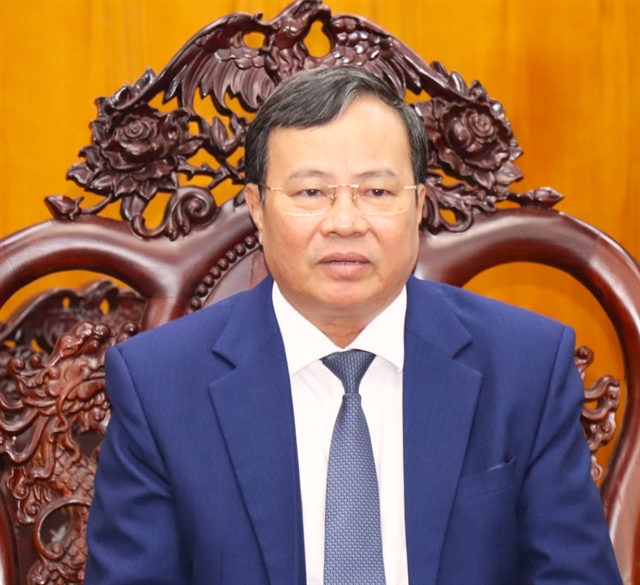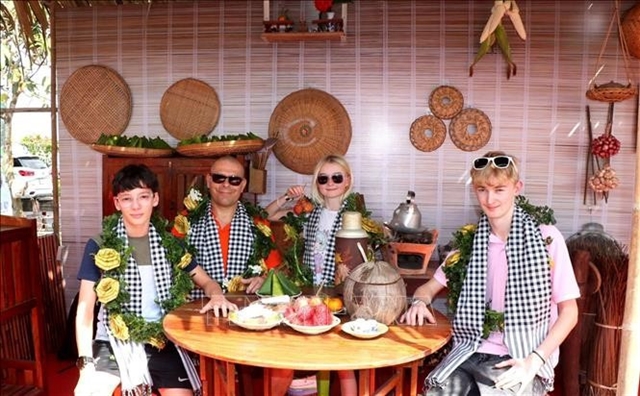 Features
Features

A new aquaculture model protects mangrove forests, boosts farmers’ incomes, and mitigates climate change impacts, Phạm Hoàng Nam reports.
 |
| Jumbo size: Chương harvests organic shrimp from the family pond. —Photo Phạm Hoàng Nam |
A new aquaculture model protects mangrove forests, boosts farmers’ incomes, and mitigates climate change impacts, Phạm Hoàng Nam reports.
Nguyễn Thị Hoa is very happy that her daughter Dzung, now pursuing a Masters degree in Australia, was able to come home last month for Tết, the Lunar New Year Festival.
Natives of the central province of Quảng Bình, Hoa and her husband, Lê Thanh Chương had invested all the money they had then in a 5-ha plot in Cà Mau’s Nhưng Miên Commune, Ngọc Hiển District since 1989.
They wanted to try their luck with shrimp farming, which was feeding the nation with rags-to-riches stories then. But, despite all the hard work they put in, there were many factors that impeded consistent success – diseases, bad weather, loss of mangroves, vagaries of the market. It looked as though their gamble might not pay off.
Three years ago, a turnaround began.
Early in 2013, Hoa’s family was one of 2,156 households living in Cà Mau’s Nhưng Miên Protective Forest invited to take part in the three-year Mangrove and Market project to get organic shrimp certification.
The project was launched by the International Union for Conservation of Nature (IUCN) and the Netherlands Development Organisation (SNV).
The goal of the project was to help local shrimp farming systems become more profitable by combining them with protection of mangrove forests, thus boosting both profitability and sustainability while also increasing coastal resilience to climate change.
For 30 years or so, shrimp farming has been one of Việt Nam’s leading export-related activities. But it has also been the leading cause of mangrove loss, and this, given the country with a long, densely populated coastline, has rendered the population vulnerable to tropical storms and sea-level rises.
Once sustainability of the shrimp business and the conservation of mangroves were both identified as national priorities, the stage was set for the Mangrove and Market project.
Funded by the German Federal Ministry of the Environment, Nature Conservation and Nuclear Safety, the project focuses on a group of around 5,300 households on an area of 24,000 hectares in the Nhưng Miên and Đất Mũi protected forests in the southernmost province’s Ngọc Hiển District.
The province has backed the implementation of an integrated model of shrimp farming that requires each household has to earmark at least 50 per cent of the land for growing mangroves.
The results have been impressive. Farmers have gained a highly diverse output, lower costs, and much lower risks of crop failure.
The model is not just disease-resistant, it has also proven to be stable and profitable, with incomes significantly higher from 15 – 20 per cent than from traditional farming.
Better still, because the farming is essentially natural, the shrimp is certified as organic under Naturland certificate, allowing farmers to meet growing international demand for organic goods that fetch premium prices.
There are 2,683 households living inside the protective forest, of whom 2,156 were trained in farming organic shrimp and 741 households (owning 2,690ha) have received the Naturland certificate so far.
“Another 1,500 households are expected to get the certificate this year,” said Tạ Minh Mẫn, deputy head of the Nhưng Miên Protected Forest Management Authority.
The project has also helped plant 80 hectares of mangrove in farms that do not meet the 50 per cent criterion, and has organised farmers into groups that work towards achieving it jointly rather than individually. Another 95 hectares of mangrove have been planted by local residents since the project began.
Households are trained to get certification in raising shrimp without giving them industrial foods or chemicals, managing household waste, and forest protection.
To support the project, the Cà Mau-based Minh Phú Company, the world’s second-largest shrimp exporter in terms of value, started to buy all the certified organic shrimp that farmers produce at a 5 - 10 per cent premium.
In the past, organic certification for shrimp farms in Việt Nam had issues like low prices, late payments, and a lack of transparency that had farmers questioning the economic value of certification. They have all been resolved with the new model.
Last year, Minh Phú company paid around VNĐ300 million ($13,500) as forest environmental services (PFES) to 200 households and other VNĐ600 million ($27, 000) for 500 households who had NaturLand certificates.
“We will provide all young shrimp for all farmers and promote training for them soon,” said Lê Văn Quang, chairman and CEO of Minh Phú.
“In the next phase of the project, expansion of international certification for organic shrimp will be important as it will help Vietnamese exporters in larger markets,” said project manager Nguyễn Thị Bích Thủy.
She also stressed the need to enhance co-operation among partners in forest planting, protection, management and aqua-culture production.
Another important thing, she added, was to complete and issue policies on payment for environmental services related to aquaculture. This will help ensure that shrimp farming can be a sustainable activity amidst climate change challenges.
“The project has helped Cà Mau a lot in developing organic shrimp breeding,” said Châ Công Bằng, deputy director of the provincial Agriculture and Rural Development Department.
The province accounts for 28 per cent of national aquaculture and 50 per cent (80,000 ha) of national mangrove forests.
Both officials and farmers feel the project has the potential to be a model of shrimp feeding and forest protection that others can emulate.
By 2020, the province targets to have 60,000 hectares that are internationally certified for organic shrimp breeding. It expects that by then, 60 per cent of its mangrove forest would be restored. —VNS




